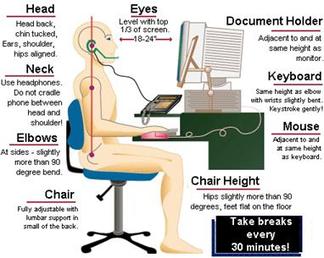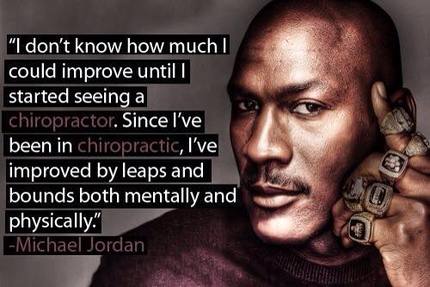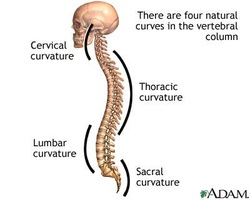Improving your Office Ergonomics
2/4/2016
By: Sonia Gashgarian, MscPT  Adults spend approximately 9.5 hours (or 69% of all waking hours) sitting each day according to Statistics Canada. Partly to blame is the fact that most job positions involve a lot of sitting – whether you are sitting in a meeting, sitting at your desk, or sitting during your commute to work. While leading a sedentary lifestyle can increase the risk of disease and health complications, too much sitting can also lead to musculoskeletal injuries. There are 3 factors that can increase the risk of injury; a combination of these factors increases injury risk even more: 1. Force 2. Repetition 3. Awkward Posture Considering the fact that a lot of office workers sit hunched forward in their office chair (an awkward posture) while working on the computer (a repetitive task), it is no wonder many people develop low back pain, neck and shoulder injuries, carpal tunnel syndrome, etc. However, there are several quick, simple, and easy changes that can be made to your desk set-up and sitting habits that will help to prevent the above mentioned injuries: 1. Adjusting the Chair. The image below outlines a better sitting alternative to sitting hunched forward. Here are some general guidelines: a. Sit right back in the chair and avoid leaning forward b. Tilt the seat pan forward so that the thighs are parallel to the floor or angled slightly downward c. Rest your feet fully on the floor, or use a foot rest if unable to reach the floor d. Recline the back rest to tilt back 100-110° e. Adjust the arm rest height so that elbows have a bit more than a 90° bend and shoulders are relaxed 2. Posture. When sitting, try to keep your ears, shoulders, and hips in line while gently squeezing the shoulder blades together and down. This will help keep the natural curves in your spine, reducing stress on the spine and surrounding muscles. 3. Monitor Placement. Keep the monitor an arm’s length away with the top of the screen no higher than eye level 4. Use a Document Holder. Keep any papers being used beside the monitor or between the keyboard and monitor. If possible, tilt the papers up towards you to allow you to glance at documents, rather than having to repeatedly bend or turn your head 5. Use a Headset. If your job requires a lot of time spent on the phone, consider using a headset instead of cradling the phone between your ear and shoulder or holding the phone for prolonged periods of time 6. Desk Layout. Keep frequently used objects and equipment within forearm’s reach and occasionally used items within arm’s reach 7. Take Breaks. Stand up and stretch for a couple of minutes every 30 minutes to 1 hour. Even if there is only time to stand up and take a few steps, it will give your body and your mind a short break 8. Set a Timer. To help implement these changes, set a timer to go off on a regular basis. For example, set a timer every 20 minutes to remind about posture, or every hour to get up and stretch If you are already starting to feel the effects of too much sitting, a physiotherapist can help in a couple of different ways: * A physiotherapist can treat any injury or pain you may develop as a result of too much sitting, helping to rehabilitate your injury and manage your pain through hands-on techniques, education, home exercises, etc. * Physical Therapists can make recommendations, above and beyond the tips outlined above, to help optimize your office and desk set-up based on your needs The physio’s role can be endless, but the over-arching goal is to help rehabilitate the current injury and prevent injuries from recurring in the future. References 1. Colley RC, Garriguet D, Janssen I, Craig CL, Clarke J, Tremblay MS. Physical activity of Canadian adults: accelerometer results from the 2007 to 2009 Canadian Health Measures Survey. (Catalogue 82-003-XPE) Statistics Canada, Health Reports. 2011 Mar;22(1). 2. University of Toronto Department of Physical Therapy. Office Ergonomics. 2015 June.
21 Comments
6 Health Benefits with Chiropractic Care
10/3/2014
By: Albert Huang, DC  What's the first thing that comes to mind when you hear the word chiropractic? Did you instantly think back or neck pain? Adjustment? Spinal health? Most people would associate going to a chiropractor with the aforementioned. Certainly, chiropractors perform adjustments and yes, chiropractic is effective in reducing back pain but is there anything more that they can help you with above and beyond spinal health? Let's explore the 6 Biggest Benefits of Chiropractic Care: 1) Stress Relief Studies show that chronic stress is related to disease onset and negative health effects. Stress is a sympathetic reaction that triggers a fight or flight response in the body. The inability to cope with stress overtime results in muscle tightness, fatigue, and nerve irritation. Chiropractor's can help lessen stress through body work, breathing techniques, and exercise prescription. Spinal adjustments can also help the body return to a more balanced, relaxed state by improving neurological function and adaptability. 2) Pain Management Chiropractic is a safe, natural, and drug-free approach to pain management. Research has shown this treatment option to be effective in reducing headaches, back, and neck pain. The goal with therapy is to address the root cause of the pain and improve function. 3) Healthier Brain function & Mind-Body connection Your brain is the master controller and orchestrates everything that happens in your body. Your attention, cognitive processing, learning, motor-control, breathing, heart rate, blood pressure, and digestion are all controlled by your brain and nerve system. Spinal misalignments may cause nerve interference and lead to mind-body dissociation. The intent of chiropractic treatment is to alleviate aberrant forces and optimize communication between the nervous system to the rest of your body. When your brain and nerve system function well, your body functions well. 4) Better Posture Chances are that you spend at least half of your day sitting. Since, humans weren't built to sit for extended periods, the majority of us experience postural changes and strains. Poor posture is related to fatigue, decreased productivity, back and neck pain. Your chiropractor is trained to provide exercise recommendations, stretches, ergonomic and lifestyle counselling, physical therapy and rehabilitative procedures to improve your musculoskeletal system and posture. 5) Improved Sex, Libido, & Reproduction Sexual function once again stems from the ability of the nervous system and endocrine to perform well. Proper communication by nerve signalling between your sex organs, hormonal center, and musculoskeletal system are important for libido health and sexual function. So how are the endocrine and nervous system linked? A part of the brain called the hypothalamus connects these two essential systems. The hypothalamus regulates basic needs such as sleep, hunger, thirst, stress response, and sex. This is why people under chiropractic care often report improvement in things like depression, anxiety, sleep patterns, energy levels, sexual performance, and reproductive function. 6) Optimize Body Performance and Overall Health The body is a self-regulating and self-healing organism that knows how to repair and preserve itself. The body heals itself through cellular processes that are directly controlled by the nervous system. It will do this as long as there is no interference in the nerve flow to the tissues. Some of the most impacting areas of chiropractic medicine include improved circulation, relaxation. better performance, enhanced mobility, and faster recovery time. Your chiropractic doctor will thoroughly assess your overall health and if they discover underlying health problems or conditions that are outside of their area of expertise, they will refer you to a medical professional who can help you. Book your appointment today and find out first hand what other benefits chiropractic can offer you! Healthy Computer Habits
8/27/2014
By: Christa Mazzuca, MScPT  Do you spend a lot of time on the computer? With our highly computerized world, many people are feeling aches and pain from spending long periods of time using a computer at work, school or home. With an optimal posture and good habits, it will be easier to work on the computer and repetitive strain injuries can be prevented. Below are a few tips to reduce strain on your body while on the computer: * Posture – Avoid slouching or awkward postures, which will put increased strain and tension on the joints, muscles and nerves of your spine and limbs. Sit up tall with your back against the back of the chair and have your feet flat on the ground (or on a stool) so your muscles aren’t doing all the work to keep you upright. You can also use lumbar support for the extra cue to sit up tall. Keep your shoulders relaxed and your arms close to your body or on the arm rest of your chair to prevent increases strain on your shoulders. Avoid leaning and resting your wrists or forearms on the edge of your desk, which can compress the nerves in your limbs. No one has perfect posture all day, but if you can correct yourself and be in a good posture for most of the day your body will be thankful. * Set-up – Position your monitor so that your eyes are about 1” below the top of your monitor; if your screen is too low you will slouch to bring your eyes to this position. Don’t squint to see the screen (eliminating glare, increasing font size or wearing corrective glasses if needed). Keep your keyboard and mouse close by with your elbows at 90° and your wrists in neutral - your mouse should be in line with and as close to your keyboard as possible. Your work, monitor, mouse and key board should be directly in front of you so you are not reaching too far and so to avoid twisting your neck or body too much. * Accessories – Use a mouse and key board that requires minimal pressure to click and type. Wrist pads on your keyboard or mouse can be used to gently place the wrist on to help keep them straight. Document holders or headsets can be used to encourage neutral neck postures. * Technique – Type slowly and softly on the keyboard with your forearms parallel to the ground and your wrists in neutral. When using a mouse don’t grip too tightly and use you elbow to move it around instead of your wrist. These techniques will prevent over working your forearm muscles and irritating the nerves of your upper limbs. * Habits – Take regular micro breaks to get up to stretch and walk around every hour to help promote blood flow to fatigued muscles. Try to vary your work tasks so you are not doing the same type of movement for extended periods. If you are experiencing the early warning signs of repetitive strain injury – such as weakness of your grip, numbness and discomfort or pain in the arms, hands, wrist or shoulders – early diagnosis and treatment is important to ensure recovery. But remember, an ounce of prevention is worth a pound of cure! By: Dr. Albert Huang, DC  In my previous blog post, 'Speaking Body Language and Posture Fundamentals' it was made known that good posture and strong body language can enhance one's mood, confidence, and success attainment. On the contrary, chronic poor posture limits our potential to be fully optimal as it reduces our mental alertness, energy, cognitive and physical function. Slouching postures place strain on the muscles and joints of the body. Overtime biomechanical imbalances develop leading to compensatory changes that cause the well known symptoms of joint stiffness, achy muscles, and generalized pain. Sluggish body postures are usually coupled with tight frontal muscles resulting in shallow constricted breathing. This forward flexed position inhibits optimal lung function which consequently decreases gas and nutrient exchange. This slows the natural rate at which toxins can be removed from our body. Let's explore 7 ways to mend bad posture and improve our body mechanics! 1) Be conscious; mind-body awareness The biggest limitation to better posture is the lack of mind-body awareness. Far too often, we are bombarded with external stimuli and tend to neglect what our body is doing or telling us. The first step to improving posture is adopting a conscious mind that persistently reminds our body to readjust its position. Whenever you find yourself beginning to slouch, make the minor adjustments to correct and bring your body into optimal alignment. Movement is your friend, laziness is not! 2) Exercise The best thing we can do for posture is to get on a regular workout plan. A well balanced regimen consisting of cardiovascular exercises and resistance weight training will build muscle systems to better support our framework. Stronger muscles are more resilient to fatigue. Building back and abdominal endurance is key to spinal stabilization and injury prevention. 3) Get assessed and treated by a Chiropractor It is always a good idea to have your posture and spine assessed by a chiropractor. Similar to how you get your teeth checked by a dentist, going to a chiropractor will help you stay preventative and on top of your spinal health. Having proper posture is important for spine mobility and nervous system function. Addressing muscular imbalances, joint motion, connective tissue pliability, ranges of motion, and functional mobility are some areas that chiropractic can help with. Ask your chiropractor for exercises to strengthen postural muscles, stretches to help your flexibility, and spinal adjustments to improve your mobility. By: Albert Huang, DC We all have heard the saying, 'don't judge a book by its cover'. Unfortunately, when it comes to physical appearance, first impressions mean everything. Statistics say that we critique and make impressions of someone within the first 7 seconds of meeting them. The way we present ourselves can influence how we are perceived by others. Body language and posture can articulate personal feelings, emotions, and physical wellbeing without a word being said. It has been shown that 55% of effective communication is articulated through body language, 38% via vocals, and 7% with words. Successful leaders have strong command in body language: a presence that reflects confidence, competence, and charisma. One medical study in Colorado, noted that people with poor posture at work reported lower energy levels leading to lethargy and reduced productivity, and that the greatest potential challenge to posture during this age of technology is sitting and working at a computer. Bad posture affects nervous system function and reduces performance output by altering spinal alignment and nerve signalling. A small, inwardly, hunched over posture articulates weakness and uncertainty whereas a tall, open, expansive posture boasts confidence and power. Making an effort to improve your posture will lead to many positive outcomes such as better body mechanics, increased energy, awareness, and self-assurance. Tune into your mind and body; show up for success.  What are the Fundamentals of Good posture? In order to improve posture, we need to establish ideal positioning and best mechanics. Our spine has 4 natural curves, a cervical lordosis, a thoracic kyphosis, a lumbar lordosis, and a small sacral kyphosis. These curves develop during childhood and are natural adaptations of being bi-pedal creatures. The spinal curves provide architectural strength and support to the spine. These curves act like a 'spring' to distribute vertical pressures on the spine and balance body weight. If the spine were absolutely straight, it would be more susceptible to buckle under compressive forces. Simple procedures to maintain your spinal curves include keeping your head centered over your body away from an anterior head carriage position. Keep this in mind especially when studying or working in front of a computer as these tasks cause the head to drift anteriorly. A simple exercise to keep the neck in proper position is the 'neck retraction exercise'. Simply contract your posterior neck muscles and tuck your chin in and backwards. Hold for 15-20 seconds - repeat daily. When standing or sitting, avoid prolonged slouching positions. Maintain an erect posture to preserve the natural lumbar curve to better absorb compressive loads. Slouching places strain on the posterior elements of the spine, compressing the vertebral discs and tensioning the spinal ligaments and muscles. Sustaining this constant pressured posture leads to symptoms of pain and an increased risk of injury. The third area to focus on is to keep our shoulders (scapulas) slightly pulled back (retracted), away from anterior forward rounding. This ensures optimal alignment of the glenohumeral joint to limit tension in the surrounding shoulder muscles and articulation. Adopting this retracted-neutral shoulder position also opens up the thorax to promote greater chest expansion during inspiration. It also reduces the likelihood of impingement related issues in the shoulders. With this said, these are all general recommendations to follow. There is no such thing as perfect posture! The best position is one that is in continual motion. Movement is postures best remedy. Body language speaks a thousand words, so get in touch with your body and strike the best pose you want to be judged for. |
AuthorPosts inspired by the team at Platinum Health & Wellness. Archives
June 2025
Categories
All
|
|
 RSS Feed
RSS Feed